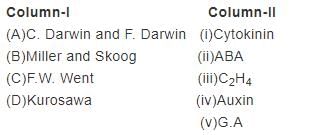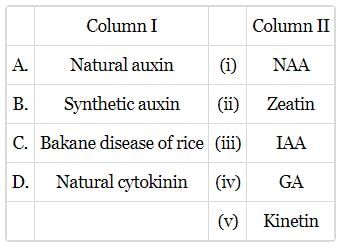Test: Plant Growth Regulators (Old NCERT) - NEET MCQ
30 Questions MCQ Test - Test: Plant Growth Regulators (Old NCERT)
Match Column-I with Column-II and select the correct option from the codes given below


Who isolated auxins from tips of coleoptiles of oat seedlings?
| 1 Crore+ students have signed up on EduRev. Have you? Download the App |
Match column I with column II and select the correct option from the codes given below.


Which of the following hormones is used in root formation on stem cutting?
Apical dominance in dicot plants is due to the presence of more_________ in the apical bud than in the lateral ones.
In addition to auxins, ................ must be supplied to the culture medium to obtain a good callus in plant tissue culture.
Read the given statements and select the correct option.
(i) Darwin and Darwin (1880) found that sensation of unilateral illumination was perceived by the coleoptile tip of canary grass.
(ii) IAA is universal natural auxin, discovered by Kogl et al.
(iii) IBA is both natural and synthetic auxin.
(iv) Auxins promote the growth of lateral shoots.
The term 'auxin precursor' refers to _________________.
The hormone responsible for apical dominance is
Which of the following effects of auxins on plants is the basis for their commercial application?
The phenomenon of apical dominace can be overcome by exogenous application of
A plant hormone that induces morphogenesis in plant tissue culture is
Induction of cell division activity and delay in senescence is caused by
The hormone which reduces transpiration rate by inducing stomatal closure is
High concentration of auxin is present in
The activity of α - amylase in the endosperm of a germinating seed of barley is induced by
Which of the following physiological effects is caused in plants by gibberellic acid?
Gibberellin was first extracted from _____________.
Removal of auxin source demonstrates that leaf abscission is _______by auxin, and apical dominance is________by auxin.
The fruits can be left on the three longer using GA so as to extend the market period. This is due to which function of GA?
Natural cytokinins are synthesised in regions where rapid cell division occurs. Such regions are

















